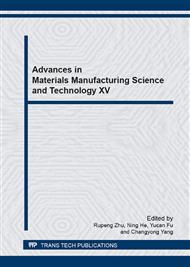p.267
p.272
p.276
p.281
p.285
p.289
p.297
p.303
p.308
Friction and Wear Morphology between Hydrogenated Titanium Alloy and Cemented Carbide
Abstract:
Ti-6Al-4V alloy was hydrogenated at 800°C by thermohydrogen treatment technology. Sliding friction and wear tests were carried out in a special tribometer assembled on CA6140 turning lathe to investigate the friction and wear morphology between hydrogenated titanium alloys and WC-Co cemented carbides. The morphological analyses of the worn surface were made by scanning electron microscope. It was found that the friction coefficient and the friction area temperature of the pair both firstly decreased and then increased with the increase of hydrogen content, and the friction coefficient decreased and the friction area temperature increased with increasing sliding speed. The main wear morphologies of the unhydrogenated alloys were serious plastic deformation, ploughing, adhesion tearing pit and fatigue microcrack, but the main wear morphologies of the hydrogenated alloys were boundary of plastic extension, slight scratch and slight adhesion tearing. Besides, the main wear morphology of the tool corresponding to unhydrogenated alloys was massive spalling, but the main wear morphology of the tool corresponding to the titanium alloy with 0.29% hydrogen content was punctate spalling.
Info:
Periodical:
Pages:
285-288
Citation:
Online since:
October 2013
Authors:
Keywords:
Price:
Сopyright:
© 2014 Trans Tech Publications Ltd. All Rights Reserved
Share:
Citation:


